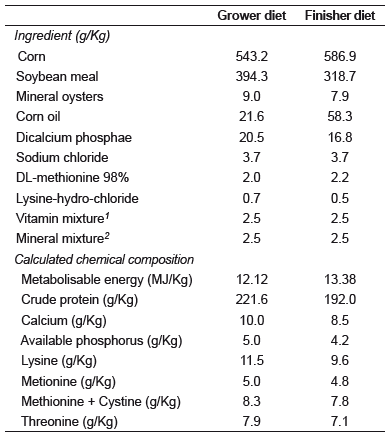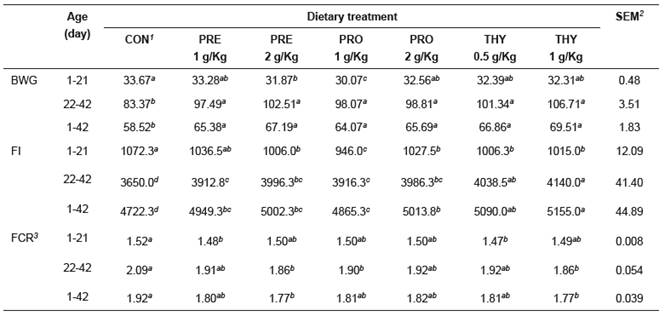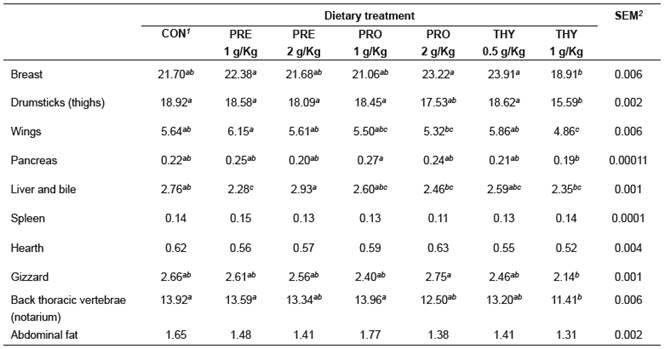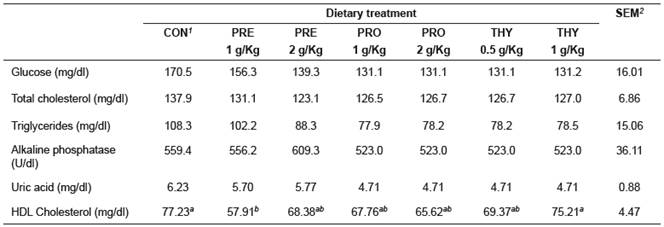Introduction
In the broiler industry, birds are often reared in confinement, which can predispose them to various diseases. Feed additives such as antibiotics, growth promoters, and anti-coccidial drugs are often used to treat diseases, enhance performance and reduce losses. However, the routine use of antibiotics in the diet of broilers is now considered to cause an increase in antimicrobial resistance of human and animal bacteria. Hence, there is a growing trend to use probiotics and prebiotics as an alternative to growth promoting antibiotics (Griggs and Jacobs, 2005; Dhama et al., 2015). Unfortunately, contradictory results have been reported on the effect of these supplements on broiler performance (Cross et al., 2007; Nayebpor et al., 2007; Willis et al., 2007; Aami-Azghadi et al., 2010; Rahimi et al., 2011; Amirdahri et al., 2012).
The purpose of our study was to simulatneously study the effect of two doses each of a prebiotic (Fermacto), a probiotic (Bioplus 2B) and thyme essential oil on growth, carcass and organ characteristics, and hematology parameters of broiler chicks. Fermacto (PetAg Inc., Hampshire, IL, USA) is derived from the fermentation of Aspergillus orizae. Fermacto enhances digestive efficiency and beneficial microflora of the gastrointestinal tract of broilers, and is, therefore, considered as a prebiotic (Ghyasi et al., 2008; Navidshad et al., 2010). Bioplus 2B is a probiotic (Chr. Hansen A/S, Boege Alle, Horsholm, Denmark) containing both Bacillus licheniformis and B. subtilis and is thought to increase the amounts of digestive enzymes (such as proteases, lipases and amylases) in the small intestine of broilers leading to better digestion of nutrients (Šabatková et al., 2008; Fallah et al., 2013). The essential oil of Thymus vulgaris (Thymol) is also considered to increase the production of digestive enzymes (Khan et al., 2012; Feizi et al., 2013).
Materials and methods
Ethical considerations
All procedures used in this study were approved by the Animal Ethics Committee of the Islamic Azad University, Rasht Branch, Iran, and were in agreement with Directive 2010/63/EU.
Location
The experiment was conducted at a commercial poultry farm (Somesara city, Guilan, Iran, latitude 37°18’15’’N, longitude 49°19’2’’E).
Birds and management
A total of 140 mixed Ross 308 broilers with similar body weight (44.0 ± 1.3 g) were randomly assigned to seven treatment groups of 20 birds/group. The experiment was repeated four times and hence the total number of birds used in the study was 560. The broilers were caged in land cages (2.0 × 1.0 × 0.5 m) and treatment groups were equally distributed between first, middle, and end positions to minimize the cage effect. All broilers were housed in a windowless and environmentally controlled room, with room temperature kept at 32 to 22 °C as appropriate for the age of the bird. The light cycle was maintained for 23 h/d during the rearing period. Each cage was equipped with an individual feeder and nipple drinker. Broilers in a cage were not able to consume feed assigned to the adjoining cage. Dietary treatments were fed from day 1 to day 42 of age. The birds were vaccinated against infectious bronchitis (1 and 7 days of age), Newcastle disease (1, 7, 20 and 30 days of age), avian influenza (1 day of age), and Gumboro disease (16 days of age).
Feed
A two-phase feeding program was used; grower feed was used from 1 to 21 days and finisher feed from 22 to 42 days. Ingredient and nutrient composition of diets are shown in Table 1. Feed and water were supplied ad libitum throughout the experimental period. The diets met or exceeded Ross 308 catalogue recommendations (Ross, 2007). The birds in the control group were given a basal diet while those in treatment groups were supplemented with the additives, as follows:
Treatment 1: Basal diet (control);
Treatment 2: Basal diet + Fermacto powder (1 g/kg);
Treatment 3: Basal diet + Fermacto powder (2 g/kg);
Treatment 4: Basal diet + Bioplus 2B powder (1 g/kg);
Treatment 5: Basal diet + Bioplus 2B powder (2 g/kg);
Treatment 6: Basal diet + thyme essential oil (0.5 g/kg);
Treatment 7: Basal diet + thyme essential oil (1 g/kg);
Table 1 Feed ingredients and nutrient analysis of grower (1 to 21 days of age) and finisher (22 to 42 days of age) diets.

1Supplied per kg of mixture: 1,081 mg trans-retinol; 20 mg cholecalciferol; 4 mg α-tocopherol acetate; 800 mg menadione; 720 mg thiamine; 2,640 mg riboflavin; 4,000 mg niacin; 12,000 mg calcium pantothenate acid; 1,200 mg pyridoxine; 400 mg folic acid; 6 mg cyanocobalamin; 40 mg biotin; 100,000 mg choline; 40,000 mg antioxidant
2Supplied per kg of mixture: 39,680 mg manganese; 20,000 mg iron; 33,880 mg zinc; 4,000 mg copper; 400 mg iodine; 80 mg selenium; 1 mg excipient
Carcass and blood characteristics
The amount of feed consumed and weight gain were recorded by pen, followed by calculation of feed conversion ratios. At day 42, one bird per group was selected for blood collection and carcass evaluation; thus, a total of four birds per treatment (one bird/treatment/replicate) were selected for this purpose. Blood samples (1 mL/bird) were collected into EDTA tubes from the wing veins. After centrifugation (3000 g x10 min at room temperature), plasma was harvested and stored at -20 ºC until assayed. Glucose, cholesterol, triglycerides, and high-density lipoproteins (HDL) were determined as reported by Shabani et al. (2015). These selected birds were then euthanized and eviscerated, and the weight of carcass, organs and body parts was recorded.
Statistical analysis
A cage was the experimental unit for performance traits while the individual bird was the experimental unit for carcass and organ characteristics, and hematological traits. The model assumptions of normality and homogeneity of variance were tested using Shapiro Wilk and Levene tests, respectively. Data were analyzed by the ANOVA option of the general linear model of SAS/STAT software (SAS Institute Inc., Cary, NC, USA) as a completely randomized design with dietary additive as the main effects. The statistical model used was: Yijk = μ + Ti + Rij + ɛijk.
Where:
Yijk = response variables from each individual replication or pen.
µ = overall mean.
Ti = effect of dietary additive.
Rij = inter-experimental unit (replications) error term.
ɛijk = intra-experimental unit error term.
Means were compared for significant differences using the LSMEANS option of SAS version 8 (SAS Institute Inc., Cary, NC, USA). Statistical significance was established at p≤0.05.
Results
The effects of feed additives on growth performance are shown in Table 2. During the entire experimental period, the broilers fed diets supplemented with Fermacto, Bioplus 2B and thyme essential oil presented higher daily weight gain than broilers fed the control diet (p<0.05), reflecting the results obtained during the finisher period. During the entire experimental period, the broiler fed diets supplemented with additives showed higher feed intake than broilers fed the control diet (p<0.05). Considering the different treatments, the highest feed intake was recorded in animals fed diets supplemented with thyme essential oil at 1 g/kg (p<0.05). Also in this case, these results reflect those obtained during the finisher period. Conversely, during the grower period, broilers fed control diet had higher feed intake than broilers fed diets supplemented with Fermacto 2 g/kg, Bioplus 2B and thyme essential oil (p<0.05). During the entire experimental period, the feeding of thyme essential oil and Fermacto at the highest level, 1 and 2 g/kg respectively, improved the feed conversion ratio compared to animals fed the control diet (p<0.05). However, feed additives did not affect live body weights at slaughter (Mean ± SE; 2627.1 ± 91.90 g; p>0.05) nor did they affect the empty abdomen carcass weight (1647.5 ± 63.76 g; p>0.05) or the eviscerated carcass percentage (62.4 ± 0.01%; p>0.05; data not shown).
Table 2 Effect of different levels of prebiotic (PRE), probiotic (PRO), and thyme (THY) essential oil supplementation on daily weight gain (BWG; g/chick/day), feed intake (FI, g/chick/duration), and feed conversion ratio (FCR) of Ross 308 broilers.

1 CON = control diet.
2 SEM = standard error of the mean.
3 FCR values were obtained as FI/BWG of the period considered.
Means with different superscript letters (a, b, c, d) within the same row differ significantly (p<0.05).
The relative weights of organs and body parts are shown in Table 3. Feeding of thyme essential oil at 1 g/kg reduced the relative weight of thighs, wings and notarium (p<0.05) of carcasses compared to the control group. The relative weight of thighs and wings increased, reducing the level of thyme essential oil from 1 to 0.5 g/kg (p<0.05). Compared with the control group, an effect of dietary additives on relative weight of breast, pancreas and gizzard was not found (p>0.05). However, broiler chickens fed thyme essential oil at 1 g/kg had lower weight of pancreas and gizzard than those fed with Bioplus 2B at 1 and 2 g/kg respectively (p<0.05). Broiler chickens fed thyme essential oil at 1 g/kg showed lower relative weight of breast than animals fed with 1 g/kg of Fermacto, Bioplus 2B at 2 g/kg and thyme essential oil at 0.5 g/kg (p>0.05). Considering the relative weight of liver and bile, broilers fed 1 g/kg of Fermacto presented lower value than those showed by broilers fed the control diet (p<0.05). There were no differences among experimental groups in relative weight of spleen, hearth and abdominal fat (p>0.05).
Table 3 Effect of different levels of prebiotic (PRE), probiotic (PRO), and thyme (THY) essential oil on relative weights of carcass cut (%) and organs (%) of Ross 308 broilers.

1 CON = control diet.
2 SEM = standard error of the means.
Means with different superscript letters (a, b, c) within the same row differ significantly (p<0.05).
There was no significant difference among groups in the plasma levels of glucose, cholesterol, triglyceride, alkaline phosphatase and uric acid (Table 4). However, high-density lipoprotein (HDL) cholesterol was significantly (p<0.05) lower in the diet containing Fermacto 1 g/kg as compared to the control diet and the diet containing thyme essential oil at 1 g/kg.
Table 4 Effect of different levels of prebiotic (PRE), probiotic (PRO), and thyme (THY) essential oil supplementation on plasma constitutes of Ross 308 broilers.

1 CON = control diet.
2 SEM = standard error of the mean.
Means with different superscript letters (a, b) within the same row differ significantly (p<0.05).
Discussion
Several authors have argued that the effect of additives on broiler performance will increase if rearing conditions, such as hygiene and dietary energy are not appropriate (Rahimi and Khaksefidi, 2006; Feizi et al., 2013). However, in the present trial, the mean daily weight gain recorded was in line with the Ross 308 performance objective (Ross, 2012) and with that reported by Ebrahimi et al. (2013). It is interesting to note that, despite all three additives affect digestion and health status of broilers, the birds in all experimental treatments achieved similar average daily weight gain at the end of the experimental period, which were higher than that of the control group. The different effect of additives during the grower and finisher periods could be due to different diet, especially in terms of protein, and to the development of the digestive tract, enhancing feed digestibility during the second part of the trial (Ocak et al., 2008). In agreement with the present study, Falaki et al. (2011) reported a 9% increase in slaughter weight and improvement in feed conversion of broilers fed 2 g/kg Fermacto. However, they did not find these effects when Fermacto was added at 1 g/kg level. Šabatková et al. (2008) reported that Bioplus 2B, even at a level lower than 1 g/kg, resulted in a 4 to 5% improvement of weight gain and feed conversion. Our results are also in agreement with those by Feizi et al. (2013) who suggested that thyme extract promoted weight gain of broilers. On the other hand, our results differ from those by Cross et al. (2011) who did not find any effect of thyme oil on broiler performance.
The control group presented similar relative weight of breast as the experimental groups. This is in agreement with the findings by Aami-Azghadi et al. (2010) and Navidshad et al. (2010); similar amino acids uptake could be hypothesized between control and experimental groups (Rostagno et al., 1995). In the present study, feeding thyme essential oil at 1 g/kg reduced relative weight of thighs, wings and back thoracic vertebrae, but did not influence the relative weight of internal organs, which is in agreement with the results obtained by Najafi and Torki (2010) and Pourmahmoud et al. (2013). These authors found that supplementation of broilers diets with thyme essential oil (0.2 g/kg) or thyme extract (up to 6 g/kg) had no effect on the relative weight of internal organs. Ayoola et al. (2014) reported that up to 30 g/kg thyme leaf inclusion in broiler diets did not influence the weight of thighs and wings.
As expected, a limited effect of feed additives on relative weight of liver, bile and spleen was observed. The overgrowth of liver and spleen may indicate a health problem; in general, our results indicate that the probiotic, prebiotic and essential oil used are not deleterious to broiler health. The relative weight of abdominal fat was similar among experimental groups indicating that, in agreement with plasma results, the additives did not influence fat accumulation. Consequently, the lack of difference in the relative weight of abdominal fat among experimental groups could reflect a similar live weight at slaughter. Similar results were also observed by Abdollahi et al. (2003), Falaki et al. (2011) and Sadeghi et al. (2012).
A limited effect of dietary additives on plasma constituents was observed. Lee et al. (2004) discussed that essential oils could inhibit hepatic 3-hydroxy-3-methylglutaryl coenzyme A -which is involved in cholesterol synthesis- while Rahimi and Khaksefidi (2006) reported that probiotics are able to reduce cholesterol absorption and synthesis in the gastrointestinal tract of broilers. However, these hypotheses do not seem to be confirmed in our study, which is in agreement with results by Sedghi et al. (2010) who supplemented broiler diet with 2 g/kg Fermacto. Our results differ with those by Bölükbaşi et al. (2006) who showed an increase of serum triglyceride and HDL in broilers fed 1 g/kg thyme oil, and with those by Ebrahimi et al. (2012) who showed that probiotics reduce serum cholesterol in broilers.
In conclusion, prebiotic (Fermacto), probiotic (Bioplus 2B) and thyme essential oil improved the average daily weight gain of broilers from 1 to 42 days of age with a limited effect on carcass characteristics and plasma constituents.














